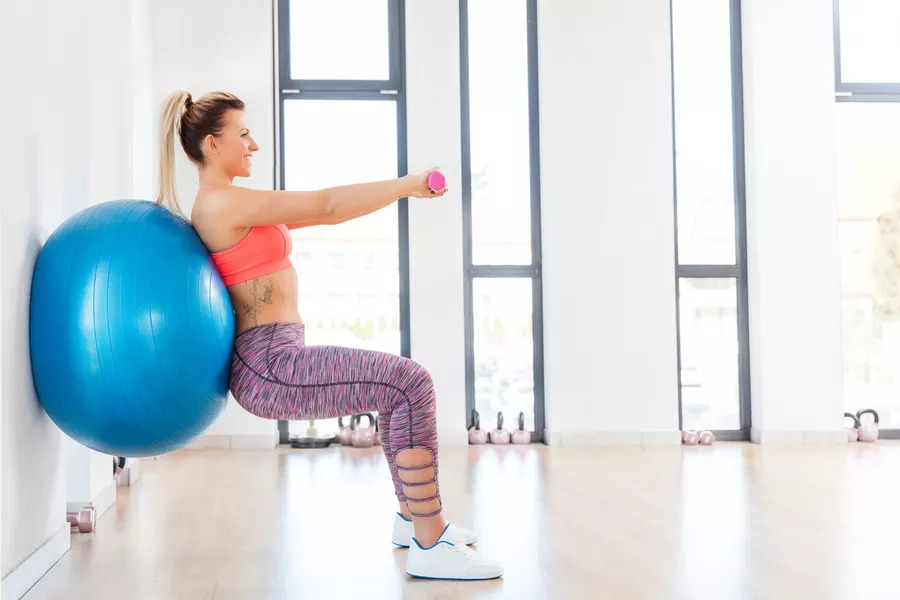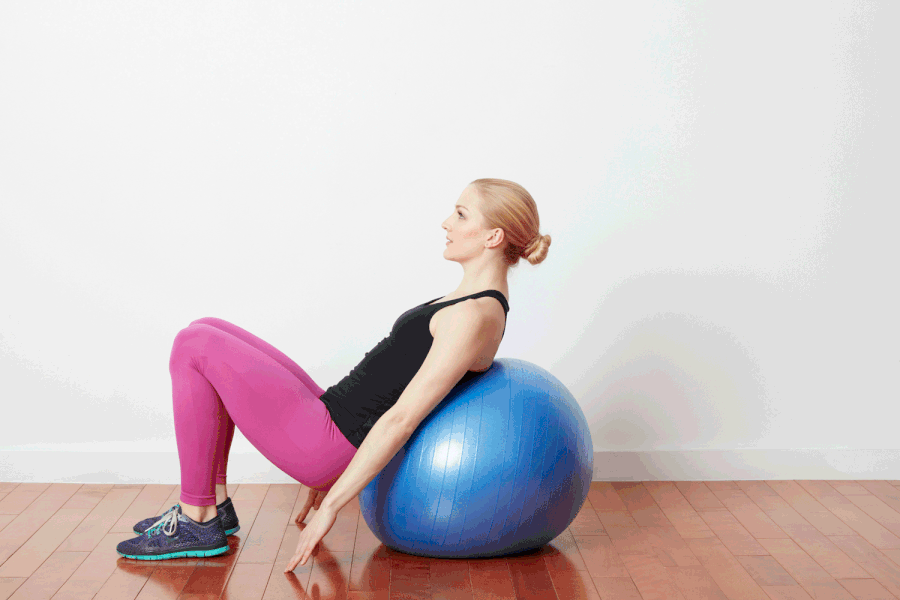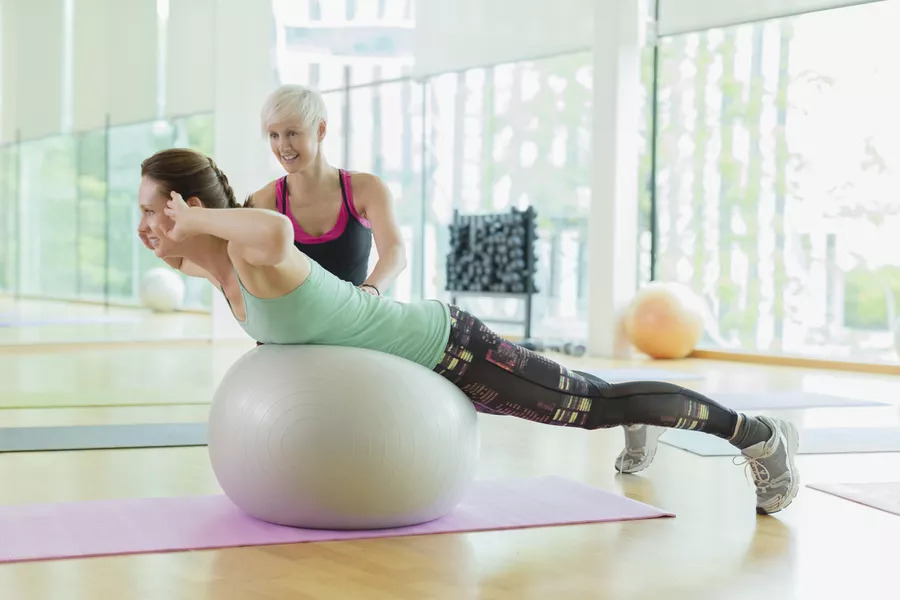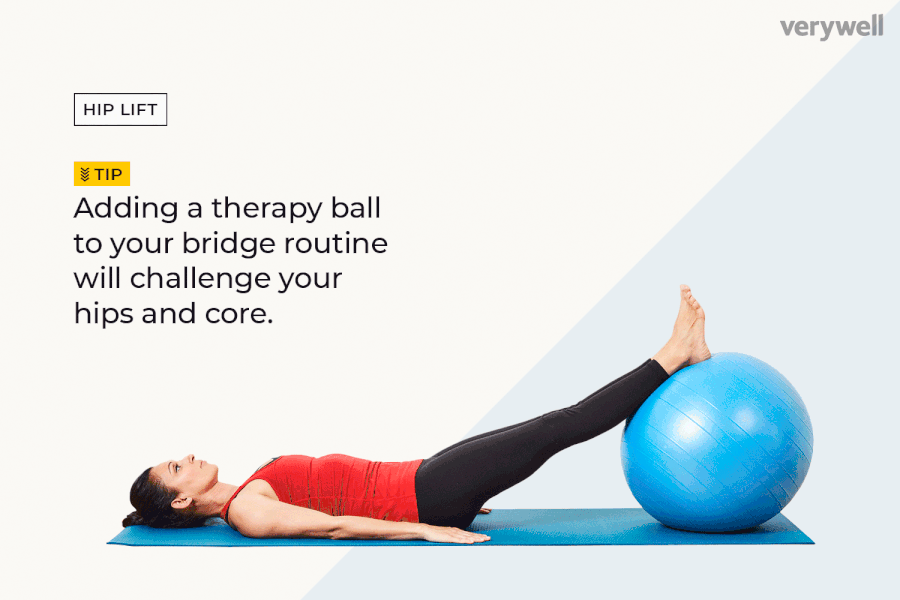Stability Ball Exercises For Seniors: We may not think much about balance and stability, but these elements are essential in everything we do, from daily work to training. Each joint is made up of ligaments and tendons connected to all the muscles that keep your body upright and in the correct position.
Table of Contents
Overview
The advantage of working on balance and stability is that you don’t need to do advanced or strenuous exercise to improve. One simple equipment (an exercise ball) can help you navigate these areas with various simple, easy to follow exercises.
Therefore the following exercises will allow you to work all areas of your body while familiarizing yourself with the ball’s unstable surface. This method is perfect if you are new to an exercise ball and gently exercise your body.
Equipment needed
The only equipment you need for these exercises is an exercise ball. You also need enough space (area) to move around. If you never used a ball before, try sitting next to a wall or holding onto a chair to keep your balance if necessary. Work your way up to doing the exercises on your own. Contact your doctor if you have an injury or medical condition.
Best Tips
Below are the basic instructions that you need to follow:
- 1.Use the first exercise to warm up your body and prepare it for the exercise.
- 2.Perform each exercise as instructed for up to three sets. If you are a beginner, start with one set and gradually work your way up to more sets over time.
- 3.If necessary, hold on to the wall for balance and use a sticky mat or shoes with good traction to prevent slipping.
- 4.Ignore any exercise that causes pain or discomfort.
Ball circles
Ball circles are the perfect introduction to relax the body and get used to sitting on the exercise ball. Make circles as small or as large as you want. As you warm up, you can deepen each circle.
Step 1: Sit on the ball and place your hands behind your head (stronger) on ball or hold onto a wall for stability.
Step 2: Slowly begin to roll your hips to the right in a circle, arching a bit as your hips roll over, then arch your back as your hips roll forward.
Step 3: Make small circles, and when you’re comfortable, make bigger circles.
Step 4: Focus on contracting your abs every time you roll the ball forward.
Step 5: Repeat for 20 circles to the right then to the left.
Ball Marches
Ball Marches are the best way to challenge your balance by taking one foot off the floor and forcing the stand to keep you stable. Hold on to a wall here. If necessary, place the ball against a wall for extra support.
Step 1: Sit on the ball with your spine straight, and your abs tightened.
Step 2: Put your hands behind your head (stiffer) or keep them on the ball and lift your right foot a few inches off the floor.
Step 3: Lower your foot and lift your left foot a few inches off the floor.
Step 4: Continue by alternately lifting your right and then your left foot.
Step 5: When you are more comfortable with the movement, raise your knees higher and walk faster.
Step 6: you can also add a crack to the ball if you are comfortable.
Step 7: Repeat for 1 to 2 minutes.
Seated ball balance
This exercise will test your balance, so take the time to practice and perfect this exercise.
Step 1: Sit on the ball with your spine straight and your abs tight.
Step 2: Put your hands on the ball behind your head (harder) or hold onto a wall for balance.
Step 3: Lift your right foot off the ground, straighten it and hold it in the air for 5 seconds or more.
Step 4: Lower and repeat on the other side.
Step 5: Repeat for 5-10 repetitions.
Step 6: Focus on tightening your abs to keep your balance.
Ball Walks
Ball walks can be challenging at their core, so take your time with it. You might want to go halfway down to test your core strength before going all the way down.
Step 1: Sit on ball, put your hands on ball behind your head, or hold on to a wall for balance.
Step 2: Start by contracting your abs and slowly moving your feet forward.
Step 3: As you walk, slowly roll your back onto the ball.
Step 4: go ahead and roll until your head and shoulders are on the ball, and your hips are raised to the bridge position.
Step 5: go back until you are seated again.
Step 6: Repeat for 10 to 15 reps.
You will find that your ball moves every time you get in and out. It is normal. Just reposition the ball when you are on the other side of the room.
Ball Squats

Ball squats not only help your balance and strengthen your glutes (muscles), hips, and thighs. A ball can be a great source if you have back or knee problems. Using a ball can often take the strain off your back and knees and give you a safe way to squat.
Step 1: Lean the ball against a wall and place it behind the lower middle of the back.
Step 2: Step out of your feet a little to lean against the ball, feet hip-width apart. If your feet are too close to the wall, you can put weight on your knees.
Step 3: Bend your knees and squat as low as possible. Try to look down to make sure your knees aren’t slipping too much over your toes.
Step 4: Keep your weight on your heels as you push yourself up and try not to lock your knees while standing.
Step 5: Repeat for 15 repetitions.
Step 6: To increase the intensity, hold the dumbbells.
Pelvic tilt on the ball
Pelvic tilts are a very subtle exercise and a great way to exercise the abs and lower back gently. Performing them on the ball adds an element of balance that harnesses all of the stabilizing muscles in the lower body.
Step 1: Sit on the ball and slowly step forward with your feet until your head and shoulders rest on the ball. Your knees should be bent about 90 degrees with your hips raised.
Step 2: Arch your back and twist your hips back and toward the ball. The movement should be small and subtle, just to feel a stretch in the abdominal muscles.
Step 3: Now bend your hips gently towards you without rolling over the ball. In other words, keep the ball steady as you move your hips.
Step 4: Continue moving your hips up and down for 15 reps.
Leg press on the ball

If you have knee complications, this exercise may not work for you. The key to this movement is to keep weight in your heels rather than toes, putting pressure on the knee.
Step 1: Sit on the ball and slowly step your feet forward until you are at an angle with the ball. Your head and shoulders should not touch the ball, and your knees should be bent.
Step 2: Bend your knees as if you are squatting.
Step 3: Push back your heels at the start.
Step 4: Repeat for 15 repetitions.
Back Extension

This movement can be a little tricky to set up. You may need to adjust the ball a few times before finding the correct type of support.
Step 1: Lie on your stomach with the ball under your hips and lower torso.
Step 2: You can rest on your knees, which is easier, or on your toes with your knees extended, which is more complicated.
Step 3: Place your hands under your chin with your elbows bent.
Step 4: Roll the ball forward, then pull your lower back together to lift your chest off the ball.
Step 5: Try to lift your shoulders until your body forms a straight line, but don’t stretch too much.
Step 6: Repeat 12 to 16 repetitions
Hip Raises

Hip raises a great way to work on balance, but you also get great workouts for your glutes and hamstrings.
Step 1: Lie on the floor with your heels on the ball.
Step 2: Keeping your abs tight, slowly lift your hips off the floor and squeeze your glutes.
Step 3: Continue until your body is in a straight line.
Step 4: Hold for a few seconds and repeat 15 times.
Step 5: To make it easier for you, place the ball under your knees instead of your heels and keep your hands on the ground. To make things more complicated, cross your arms over your chest. If your knees are uncomfortable in this locked position, roll the ball with your feet as your hips lift.
Seven reasons to use an exercise ball in your workout
An exercise ball is a versatile and dynamic exercise tool that you should thoughtfully incorporate into your exercise routine. You can incorporate an exercise ball into almost any workout to challenge your body and take your fitness, especially core stability, to the next level.
Stability balls can be a little complicated at first in learning balance, but you’ll quickly find that they’re simple, lightweight, and great for balance, core, and muscle isolation. So, that being said, exercise balls are fun, and here are the seven reasons why you should include them in your workout routine!
1. BODY WEIGHT
Body weight training is beneficial both mentally and physically because you are essentially working against your body weight. From planks, push-ups, dips, and climbers, most exercise routines can incorporate an exercise ball and improve results.
As an example of the benefits of the exercise ball, when combined with an exercise ball, climbers can relieve tension in your shoulders and arms and help you pay more attention to core movement.
2. STRENGTHENS YOUR CORE
It’s time to swap your workout bench for an exercise ball! Pretty much any workout you do on a bench can be done on an exercise ball, which makes it more challenging and, therefore, more rewarding. These include rows, bar presses, and bicep curls.
Doing all of this will also strengthen your core, as you will have to use your abdominal muscles to maintain stability constantly.
3. IMPROVE YOUR FLEXIBILITY
Regular use of an exercise ball during your exercise program can improve your flexibility. Even if the ball isn’t part of your exercise routine, you can use it to stretch and warm up your muscles before your workout begins.
Therefore, It reduces the risk of injury and keeps your joints and muscles optimally functional.
4. IMPROVE YOUR BALANCE
It is an exercise ball for a good reason. Just sitting on an exercise ball puts a strain on your stabilizing muscles. Sitting on an exercise ball (stability ball) needs using your back and abdominal muscles to maintain balance on the ball. Including an exercise ball into your routine can be beneficial for maintaining a healthy posture.
However, you must maintain proper alignment during any exercise routine that involves an exercise ball to avoid injury.
5. BACK AND SPINE HEALTH
Of all seven reasons to use an exercise ball in your exercise regimen, this is probably the most common among physical therapists. So, the stability ball can be very useful if you have back problems as it will help your lower back stretch and exercise.
Therefore for this reason, chiropractors and physical therapists often recommend using the exercise ball in your exercise routine.
6. CARDIO RUN
Incorporating an exercise ball into your cardio workout is an effective way to increase your heart rate. Since stability balls are light in weight, you can easily incorporate them into a series of quick moves to improve your burn.
Plank, woodchip, and stability ball exercises worldwide are pretty intense and fun while keeping your energy and optimism alive.
7. AID FOR SPORTING PERFORMANCE
If you are a sports enthusiast, you will appreciate how the exercise ball’s naturally unstable and soft surface activates your core structure, strengthens your abdominal muscles, and improves proprioception (body awareness while moving around the body), space, balance, coordination, and posture.
These skills lead directly to improved fitness and athletic performance, as well as better protection against injury.
THE CONCLUSION
As you can see, incorporating an exercise ball into your exercise routine has many health benefits. You will be able to strengthen your core, improve your balance, coordination, flexibility, and alleviate certain complications related to your back and spine.
Therefore, the stability ball is light, soft, easy to maneuver, and probably the most fun exercise tool you’ll ever use.
ALSO READ: Flexible Intermittent Fasting Schedules For Weight Loss – By Experts







